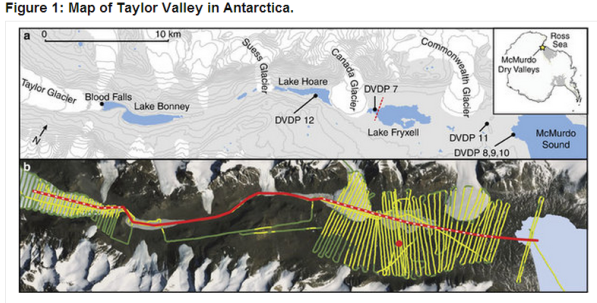Our understanding of Antarctica’s subsurface environments has advanced dramatically in recent decades. We now know that subglacial water is widespread with at least half of the areas covered by the Antarctic ice sheet having aqueous systems beneath that are analogous to lakes and wetlands on other continents1, 2, 3. However, little is known about groundwater in Antarctica’s ice-free regions and connectivity of these fluids to the coastal margins. Recent measurements have shown direct submarine groundwater discharge near Lützow–Holm Bay, Antarctica4 and the volumes of these groundwater contributions from the continent to the Southern Ocean may be significant5. While very few of these subsurface aquatic environments have been sampled, all have harboured microorganisms6, 7, 8. The metabolic activity of these microbial communities enhances mineral weathering, resulting in the subsequent release of solutes, see, for example, refs 9, 10such that subglacial groundwater discharges may contribute a significant flux of essential nutrients to affect near-shore lacustrine and marine productivity11, 12.

The McMurdo Dry Valleys (MDV), situated along the Ross Sea coastline, is the largest ice-free region in Antarctica13. Following their discovery by the Robert Scott expedition of the early twentieth century, international researchers have extensively studied the MDV, beginning with the International Geophysical Year programme in 1957 and continuing with the current US long-term ecological research programme. The McMurdo long-term ecological research programme14 was established in 1993 and provides the longest continuous record of physical and biological information for Taylor Valley (Fig. 1a) and other locales in the MDV. Our current understanding of hydrological linkages in the MDV is based primarily on observed surface processes15. Local glaciers are defined as cold based with beds below the pressure melting temperature of freshwater16. On seasonal timescales, supraglacial melt generated during the austral summer feeds perennial streams, which then interact with desert soils dissolving solutes and redistributing nutrients, ultimately transferring nutrients to ice-covered lakes14. On longer timescales, the size and chemistry of the ice-covered lakes fluctuate in response to climate17. These changing paleolake levels are thought to create ecological resource legacies of salts, organic matter and landscape change that influence contemporary ecosystem production and biodiversity

